(Adding categories) |
(Expanding caption for re-uploaded image) |
||
| (18 intermediate revisions by 10 users not shown) | |||
| Line 1: | Line 1: | ||
| + | [[File:Burst Missile Impact.png|thumb|300px|''[[Scinfaxi]]'' burst missile impact over the [[Eaglin Straits]] during Osea's [[Operation Whalebird]]; note the shockwave at the lower-left indicating the surface of the water]] |
||
| − | '''Burst missiles''' are a type of long-range [http://en.wikipedia.org/wiki/Ballistic_missile ballistic missile] produced in the [[Strangereal]] world. The weapon derives its name from the method of detonation, where it usually splits into multiple warheads, each detonating in a massive ballistic explosion in mid-air, destroying anything in a 2,500 ft. radius. |
||
| + | {{Quote|What the hell was that attack? It was like molten steel raining down on us!|[[3rd Osean Naval Fleet]] crewmember}} |
||
| + | '''Burst missiles''' are missiles carrying a fictional warhead that explodes in a powerful mid-air burst. These bursts are typically accompanied by a distinctive flash of light. |
||
| + | |||
| + | Various types of missiles can carry burst warheads, including [[cruise missile]]s, [[ballistic missile]]s, and the [[Multi-Purpose Burst Missile]] special weapon. The [[Scinfaxi-class submarine|''Scinfaxi''-class]] of submarines are notable for carrying ballistic missiles that each contain multiple burst warheads. |
||
| + | |||
==History== |
==History== |
||
| − | ===Development |
+ | ===Development=== |
| + | [[File:MPBM.jpg|thumb|250px|Belka's Multi-Purpose Burst Missile, for use on Morgan aircraft]] |
||
| + | The concept of burst missiles was developed in tandem within the countries of [[Belka]] and [[Yuktobania]] in the 1980s and 1990s, during the [[Cold War]]. |
||
| ⚫ | Yuktobania's burst missiles were created to be an improvement over existing [[intercontinental ballistic missile]]s of the period. The first burst missile warheads were field-tested by the Yuktobanian military in 1991.{{Ref|Follow|''FOLLOW'', [http://acecombat.jp/ace5/top.htm ACES WEB]. Published September 4, 1991.}} The completed missiles were later equipped to the [[Yuktobanian Navy]]'s ''[[Scinfaxi]]'' and ''[[Hrimfaxi]]'' submersible aircraft carriers.{{Refcall|AC5-M07}}{{Refcall|AC5-M13}} |
||
| − | [[File:Scinfaxi Dock Desktop.jpg|thumb|242px|The ''Scinfaxi'', a burst missile launch platform.]]The concept of burst missiles was first conceived in the 1980s during the [[Cold War]], being born as a result of [[Yuktobania]]'s development of ballistic missile technology. |
||
| − | [[File:Burst_Missile_Impact.png|thumb|Missile Impact During The Mission [[Rendezvous]]]] |
||
| − | [[File:In_Game_Burst_Missile.png|thumb|Missile Impact During The Mission [[Demons of Razgriz]]]] |
||
| ⚫ | |||
| + | Belka's burst missiles were developed to a lesser extent than Yuktobania’s. Codenamed "Hypersthene", the [[Multi-Purpose Burst Missile]] had single warheads and was designed to be carried by the [[ADFX-01 Morgan|ADFX-01]] and [[ADFX-02 Morgan]] prototype aircraft.{{Ref|AAW-57|''[[Aces At War: A History]]'', page 57.}} |
||
| − | Burst missiles were first deployed in combat during the [[Circum-Pacific War]] in late 2010. They were first deployed by the Scinfaxi during an operation in September 30 to stop the surviving [[Osean Maritime Defense Force]] carriers as they crossed the [[Eaglin Straits]], destroying nearly the entire Osean force in the process. Later on, during the amphibious invasion of [[Sand Island]], it launched several missiles to attack the defending Osean air units. Most of the missiles either detonated successfully or were destroyed by the [[Arkbird]], while the rest were lost when the submarine fell to the attacks of the [[108th Tactical Fighter Squadron]]. |
||
| + | [[Estovakia]] also developed burst missiles, known as the "[[Nimbus missile|Nimbus]]". It was designed to be deployed on the [[P-1112 Aigaion]], which was constructed using classified Belkan technology provided to the [[Eastern Faction]] by [[Lorenz Riedel]].{{Ref|AC6-AR-21|''[[Ace Combat 6: Fires of Liberation]]'', [[Ace Combat 6: Fires of Liberation/Aces|Assault Record]] #21 - [[Lorenz Riedel]].}} |
||
| − | The last use of burst missiles in the war occurred on November 14, when the [[Hrimfaxi]], the Scinfaxi's lower-cost relative, staged missile attacks from the [[Razgriz Straits]] in northern [[Estovakia]] to stop a large scale offensive of the Osean army. The attacks were stopped by the Wardog Squadron after a fierce battle with the submarine, which ended in its destruction and the loss of all remaining burst missiles within it. |
||
| + | |||
| − | ===Development in the Belkan Federation=== |
||
| + | Some time before or during the [[Lighthouse War]], [[Erusea]] acquired long-range burst missiles known as [[Helios]]. Despite being designed to be carried by [[Osea]]n-made [[Arsenal Bird]]s, the Osean [[AWACS Bandog]] was unaware of their existence until Osean headquarters provided intelligence on them<ref name="AC7-M09">{{Cite game|AC7|M09}}</ref>, suggesting it was developed by Erusea, or possibly Belka, considering they supplied Erusea with various technologies.<ref name="AC7-M16">{{Cite game|AC7|M16}}</ref> |
||
| − | The development of burst missiles also took place within the [[Belkan Federation]], although in a lesser scale compared to Yuktobania. Codenamed "Hypersthene", they were ballistic missiles designed to be carried by the [[ADFX-02 Morgan]] prototype fighter. |
||
| + | |||
| − | ==Design characteristics== |
||
| + | ===Deployment=== |
||
| − | There are only two known defenses against a burst missile attack: destroy the warheads before they detonate, or evasive maneuvers. When burst missiles are fired at ground targets, air units can maintain an altitude of above 5,000 feet to avoid the missiles. Ships can attempt evasive maneuvers, but are not always successful. |
||
| + | Burst missile technology was first employed in combat during the [[A World With No Boundaries]] uprising following the [[Belkan War]] in 1995. The organization had stolen Belka's single ADFX-02 Morgan model, which was used by [[Larry Foulke]] to duel [[Cipher]]. In the middle of the battle, Foulke fired the aircraft's burst missiles, but Cipher managed to dodge them and eventually shoot him down.{{Ref|ACZ-M18|[[Zero]], ''[[Ace Combat Zero: The Belkan War]]''.}} |
||
| + | |||
| + | [[File:In Game Burst Missile.png|thumb|250px|A ''Hrimfaxi''-launched burst missile detonates over the [[Razgriz Straits]]]] |
||
| + | |||
| + | Burst missiles were later employed in combat during the [[Circum-Pacific War]] in late 2010. During the conflict, the ''Scinfaxi'' and ''Hrimfaxi'' utilized their arsenal of burst missiles to devastating effect against the Osean forces. The first known use occurred on September 30, 2010, when ''Scinfaxi''-launched burst missiles sank two Osean aircraft carriers and shot down numerous Osean escort fighters over the [[Eaglin Straits]].{{Ref|AC5-M05|[[Rendezvous]], ''[[Ace Combat 5: The Unsung War]]''.}} On October 4, the ''Scinfaxi''{{'}}s burst missiles were used to support Yuktobania's attempted invasion of [[Sand Island Air Force Base|Sand Island]]; the burst-missile warheads once again inflicted considerable casualties to the Osean air forces in the airspace.{{Ref|AC5-M07|[[Front Line]], ''[[Ace Combat 5: The Unsung War]]''.}} |
||
| + | |||
| + | The second and last known use of Yuktobanian burst missiles took place on November 14, 2010, when the ''Hrimfaxi'' successfully forestalled an Osean offensive into the Yuktobanian mainland. The ''Hrimfaxi''-launched burst missiles inflicted enough casualties and damage to the Osean army that it temporarily postponed the inland offensive.{{Ref|AC5-M13|[[Demons of Razgriz]], ''[[Ace Combat 5: The Unsung War]]''.}} |
||
| + | |||
| + | On October 29, 2013, the Eastern Faction deployed the P-1112 Aigaion in the final battle of the [[Estovakian Civil War]].{{Ref|AAW-2019|''[[Aces At War: A History 2019]]'', pages 144–145.}} With the use of its burst missiles, it devasted the [[Lyes United Front]].{{Ref|AC6-AR-10|''[[Ace Combat 6: Fires of Liberation]]'', [[Ace Combat 6: Fires of Liberation/Aces|Assault Record]] #10 - [[Yaroslav Deryagin]].}} |
||
| + | |||
| + | [[File:Nimbus missiles.jpg|250px|thumb|Nimbus missiles above Gracemeria]] |
||
| + | Estovakian burst missiles were utilized once again during the [[Emmeria-Estovakia War]], where they were used to force the [[Emmeria]]n military to abandon their capital city, [[Gracemeria]], on August 30, 2015.<ref name="AC6-M01">{{Cite game|AC6|M01}}</ref> The P-1112 Aigaion, alongside the [[South Sea Fleet]], later defended Gracemeria four times during the [[King & Balloon Operations]].{{Ref|AC6-AR-25|''[[Ace Combat 6: Fires of Liberation]]'', [[Ace Combat 6: Fires of Liberation/Aces|Assault Record]] #25 - [[Valeriy Nikitov]].}} In September, the use of burst missiles secured [[San Loma]] for Estovakia and forced the [[Republic of Emmeria Air Force]] to retreat west.{{Ref|TheAerialFleet|''[[The Aerial Fleet]]''.}} Throughout November, Nimbus missiles were used against the retreating Emmerian forces.{{Refcall|AAW-2019}} |
||
| + | |||
| + | Burst missiles were not used again until February 12, 2016, when the Emmerians attempted to advance through the [[Selumna Peaks]].<ref name="AC6-M07">{{Cite game|AC6|M07}}</ref> Three days later, Estovakia deployed burst missiles to prevent the Emmerians from recapturing San Loma, an endeavor which ultimately failed.<ref name="AC6-M08">{{Cite game|AC6|M08}}</ref> On February 20, the P-1112 Aigaion deployed its Nimbus missiles once again to defend itself, before [[Garuda Team]] shot it down.<ref name="AC6-M09">{{Cite game|AC6|M09}}</ref> |
||
| + | |||
| + | [[File:Helios Faceless Soldier AC7.jpg|250px|thumb|Helios missiles above [[Waiapolo Mountains]].]] |
||
| + | Erusean burst missiles were first used during the [[Lighthouse War]] on July 27, 2019, in an attempt to shoot down [[Spare Squadron]] which was deployed to destroy a major Erusean communications facility, but eventually failed to do so.<ref name="AC7-M09"/> They were later used by Erusean radicals during [[Operation Daredevil]] on October 31, 2019; the remaining Arsenal Bird ''Justice'' fired multiple Helios missiles around the [[International Space Elevator|Space Elevator]] to inflict severe losses to the Osean-Erusean coalition; after failing to repel them, the Arsenal Bird entered the airspace and was shot down by [[Trigger]].<ref name="AC7-M19">{{Cite game|AC7|M19}}</ref> |
||
| + | |||
| + | ==Design== |
||
| + | ===Advantages=== |
||
| + | Burst missiles share many basic design characteristics with intercontinental ballistic missiles and are capable of hitting targets from thousands of miles away. This extended range allowed the launch site or vessel to attack targets from a safe distance (e.g. the ''Hrimfaxi'' targeted Osean ground troops from the safety of the [[Razgriz Straits]]).{{Refcall|AC5-M13}} |
||
| + | |||
| + | Each burst-missile warhead contains multiple smaller warheads, which separate and spread out in mid-air over their target before detonating; each warhead has a blast radius of 2,500 feet. The sheer concussive power and intense heat of the blasts was described by the Oseans as "molten steel raining down" on them.{{Refcall|AC5-M05}} |
||
| + | |||
| + | ===Limitations=== |
||
| + | When burst missiles are fired at ground targets, they must detonate at a certain altitude in order for the explosions to envelope the ground; this means that air units can ascend to a higher altitude (usually above 5,000 feet) and safely fly over the missile detonations. This weakness would be exploited by Osea's [[Wardog Squadron]] during the engagements in which the ''Scinfaxi'' and ''Hrimfaxi'' were sunk.{{Refcall|AC5-M07}}{{Refcall|AC5-M13}} |
||
| + | |||
| + | Burst missiles are also extremely vulnerable during the early {{Wp|boost phase}} after initial launch; furthermore, underwater missile launches generate enough sonar resonance that the submersible performing the launch can be located and targeted.{{Refcall|AC5-M07}} |
||
| − | The only known method of destroying the warheads before detonation was deployed by the Arkbird. A separate unit, such as an [[AWACS]] or an anti-submarine plane, must lock on to the missile when it is fired. From there, a data link must be sent to the Arkbird. Once the Arkbird receives the missile trajectory, it can fire its laser at an angle where the missile will have to cross. The missile, and the warheads, are then vaporized by the laser. However, with the destruction of the Arkbird by the [[Razgriz Squadron]], it is unknown if any country has the means to destroy the missile or its warheads. |
||
==Trivia== |
==Trivia== |
||
| − | *The |
+ | *The final cruise missile in [[Breaking Arrows]] in ''[[Ace Combat 04: Shattered Skies]]'' bears a similar explosion effect to burst missiles. |
| + | |||
| + | {{Reflist}} |
||
[[Category:Missiles]] |
[[Category:Missiles]] |
||
| − | [[Category: |
+ | [[Category:Superweapons]] |
| − | [[Category: |
+ | [[Category:Weapons]] |
| − | [[Category:BVR Weaponry]] |
||
Revision as of 00:51, 17 April 2020
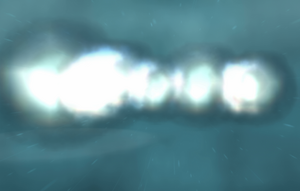
Scinfaxi burst missile impact over the Eaglin Straits during Osea's Operation Whalebird; note the shockwave at the lower-left indicating the surface of the water
- "What the hell was that attack? It was like molten steel raining down on us!"
- ― 3rd Osean Naval Fleet crewmember
Burst missiles are missiles carrying a fictional warhead that explodes in a powerful mid-air burst. These bursts are typically accompanied by a distinctive flash of light.
Various types of missiles can carry burst warheads, including cruise missiles, ballistic missiles, and the Multi-Purpose Burst Missile special weapon. The Scinfaxi-class of submarines are notable for carrying ballistic missiles that each contain multiple burst warheads.
History
Development
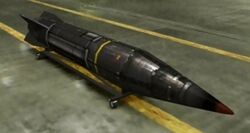
Belka's Multi-Purpose Burst Missile, for use on Morgan aircraft
The concept of burst missiles was developed in tandem within the countries of Belka and Yuktobania in the 1980s and 1990s, during the Cold War.
Yuktobania's burst missiles were created to be an improvement over existing intercontinental ballistic missiles of the period. The first burst missile warheads were field-tested by the Yuktobanian military in 1991.[1] The completed missiles were later equipped to the Yuktobanian Navy's Scinfaxi and Hrimfaxi submersible aircraft carriers.[2][3]
Belka's burst missiles were developed to a lesser extent than Yuktobania’s. Codenamed "Hypersthene", the Multi-Purpose Burst Missile had single warheads and was designed to be carried by the ADFX-01 and ADFX-02 Morgan prototype aircraft.[4]
Estovakia also developed burst missiles, known as the "Nimbus". It was designed to be deployed on the P-1112 Aigaion, which was constructed using classified Belkan technology provided to the Eastern Faction by Lorenz Riedel.[5]
Some time before or during the Lighthouse War, Erusea acquired long-range burst missiles known as Helios. Despite being designed to be carried by Osean-made Arsenal Birds, the Osean AWACS Bandog was unaware of their existence until Osean headquarters provided intelligence on them[6], suggesting it was developed by Erusea, or possibly Belka, considering they supplied Erusea with various technologies.[7]
Deployment
Burst missile technology was first employed in combat during the A World With No Boundaries uprising following the Belkan War in 1995. The organization had stolen Belka's single ADFX-02 Morgan model, which was used by Larry Foulke to duel Cipher. In the middle of the battle, Foulke fired the aircraft's burst missiles, but Cipher managed to dodge them and eventually shoot him down.[8]
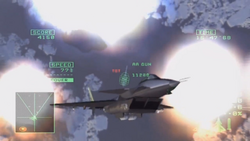
A Hrimfaxi-launched burst missile detonates over the Razgriz Straits
Burst missiles were later employed in combat during the Circum-Pacific War in late 2010. During the conflict, the Scinfaxi and Hrimfaxi utilized their arsenal of burst missiles to devastating effect against the Osean forces. The first known use occurred on September 30, 2010, when Scinfaxi-launched burst missiles sank two Osean aircraft carriers and shot down numerous Osean escort fighters over the Eaglin Straits.[9] On October 4, the Scinfaxi's burst missiles were used to support Yuktobania's attempted invasion of Sand Island; the burst-missile warheads once again inflicted considerable casualties to the Osean air forces in the airspace.[2]
The second and last known use of Yuktobanian burst missiles took place on November 14, 2010, when the Hrimfaxi successfully forestalled an Osean offensive into the Yuktobanian mainland. The Hrimfaxi-launched burst missiles inflicted enough casualties and damage to the Osean army that it temporarily postponed the inland offensive.[3]
On October 29, 2013, the Eastern Faction deployed the P-1112 Aigaion in the final battle of the Estovakian Civil War.[10] With the use of its burst missiles, it devasted the Lyes United Front.[11]
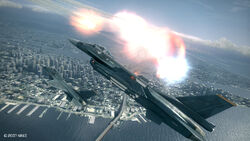
Nimbus missiles above Gracemeria
Estovakian burst missiles were utilized once again during the Emmeria-Estovakia War, where they were used to force the Emmerian military to abandon their capital city, Gracemeria, on August 30, 2015.[12] The P-1112 Aigaion, alongside the South Sea Fleet, later defended Gracemeria four times during the King & Balloon Operations.[13] In September, the use of burst missiles secured San Loma for Estovakia and forced the Republic of Emmeria Air Force to retreat west.[14] Throughout November, Nimbus missiles were used against the retreating Emmerian forces.[10]
Burst missiles were not used again until February 12, 2016, when the Emmerians attempted to advance through the Selumna Peaks.[15] Three days later, Estovakia deployed burst missiles to prevent the Emmerians from recapturing San Loma, an endeavor which ultimately failed.[16] On February 20, the P-1112 Aigaion deployed its Nimbus missiles once again to defend itself, before Garuda Team shot it down.[17]
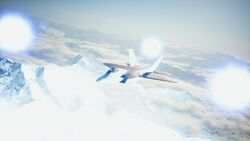
Helios missiles above Waiapolo Mountains.
Erusean burst missiles were first used during the Lighthouse War on July 27, 2019, in an attempt to shoot down Spare Squadron which was deployed to destroy a major Erusean communications facility, but eventually failed to do so.[6] They were later used by Erusean radicals during Operation Daredevil on October 31, 2019; the remaining Arsenal Bird Justice fired multiple Helios missiles around the Space Elevator to inflict severe losses to the Osean-Erusean coalition; after failing to repel them, the Arsenal Bird entered the airspace and was shot down by Trigger.[18]
Design
Advantages
Burst missiles share many basic design characteristics with intercontinental ballistic missiles and are capable of hitting targets from thousands of miles away. This extended range allowed the launch site or vessel to attack targets from a safe distance (e.g. the Hrimfaxi targeted Osean ground troops from the safety of the Razgriz Straits).[3]
Each burst-missile warhead contains multiple smaller warheads, which separate and spread out in mid-air over their target before detonating; each warhead has a blast radius of 2,500 feet. The sheer concussive power and intense heat of the blasts was described by the Oseans as "molten steel raining down" on them.[9]
Limitations
When burst missiles are fired at ground targets, they must detonate at a certain altitude in order for the explosions to envelope the ground; this means that air units can ascend to a higher altitude (usually above 5,000 feet) and safely fly over the missile detonations. This weakness would be exploited by Osea's Wardog Squadron during the engagements in which the Scinfaxi and Hrimfaxi were sunk.[2][3]
Burst missiles are also extremely vulnerable during the early boost phase after initial launch; furthermore, underwater missile launches generate enough sonar resonance that the submersible performing the launch can be located and targeted.[2]
Trivia
- The final cruise missile in Breaking Arrows in Ace Combat 04: Shattered Skies bears a similar explosion effect to burst missiles.
References
- ↑ FOLLOW, ACES WEB. Published September 4, 1991.
- ↑ 2.0 2.1 2.2 2.3 Front Line, Ace Combat 5: The Unsung War.
- ↑ 3.0 3.1 3.2 3.3 Demons of Razgriz, Ace Combat 5: The Unsung War.
- ↑ Aces At War: A History, page 57.
- ↑ Ace Combat 6: Fires of Liberation, Assault Record #21 - Lorenz Riedel.
- ↑ 6.0 6.1 Mission 09: "Faceless Soldier", Ace Combat 7: Skies Unknown.
- ↑ Mission 16: "Last Hope", Ace Combat 7: Skies Unknown.
- ↑ Zero, Ace Combat Zero: The Belkan War.
- ↑ 9.0 9.1 Rendezvous, Ace Combat 5: The Unsung War.
- ↑ 10.0 10.1 Aces At War: A History 2019, pages 144–145.
- ↑ Ace Combat 6: Fires of Liberation, Assault Record #10 - Yaroslav Deryagin.
- ↑ Mission 01: "Invasion of Gracemeria", Ace Combat 6: Fires of Liberation.
- ↑ Ace Combat 6: Fires of Liberation, Assault Record #25 - Valeriy Nikitov.
- ↑ The Aerial Fleet.
- ↑ Mission 07: "Selumna Peak", Ace Combat 6: Fires of Liberation.
- ↑ Mission 08: "San Loma Assault", Ace Combat 6: Fires of Liberation.
- ↑ Mission 09: "Heavy Command Cruiser", Ace Combat 6: Fires of Liberation.
- ↑ Mission 19: "Lighthouse", Ace Combat 7: Skies Unknown.
